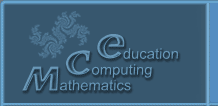|
|
PresentationsProject-based physics and math education in Montessori schoolsMIMP, Russia, Moscow, E-mail, 7282325@gmail.com 1JINR, Russia, Dubna, pdshirkov@gmail.com What about Montessori teachers who enter with their students into the “Jungle” of modern education and its basis - physics, without having the appropriate subject basis? What kind of math should be taught to future graduates to make them in-demand specialists? How can a teacher of science and mathematics not only look at the subject content of their disciplines differently, but also help their students to see in it not formulas, but meanings, connections, reflections of the integrity of the Universe? And after all, students of the Montessori system will have to pass final certification according to the current state legal acts. FSES [1] sets the vector of movement, but does not provide a method to solve these (and not only...) contradictory problems inherent in any system of education. To partially overcome these obstacles, the paper proposes to use the method of project-based learning of research activity based on the methodology of modeling [2]. This approach, which assumes in the conditions of careful mentoring by a more experienced teacher of independent “discovery” by students of the key subject content of the discipline, not only allows the participants of the learning process to master the main tool of cognition - modeling, but also helps to support the motivation of learning, returns the main methods of the subject to their practical essence, restores interdisciplinary and meta-subject links [3]. To prepare teachers of Montessori education to use the project approach for ages 9-12 and older, the International Institute of Montessori Pedagogy organized a professional development course on the basis of the International Institute of Montessori Pedagogy, in which future project mentors develop the content of applied projects in physics, mathematics and technology. This year the students chose project areas related to the creation of their own weather station, the design and construction of a structure that can be transported in the trunk of a family car, and the design of a means of transportation on water.
Literature 1. FGOS-OOO-na-17.02.2023.pdf (ntf-iro.ru). 2. Zakharieva N.L., Khoziev V.B., Shirkov P.D., "Modeling and Education.” // Journal of Mathematical Modeling ,Vol. 11, No. 5, 1999. - с. 101-116. 3. Khutorskoi A.V. Meta-subject content in the standards of the new generation. // “School Technologies”, 2012, No. 4. - M.: “Narodnoe Obrazovanie”, 2012. - с. 36-47.
Presentation |

